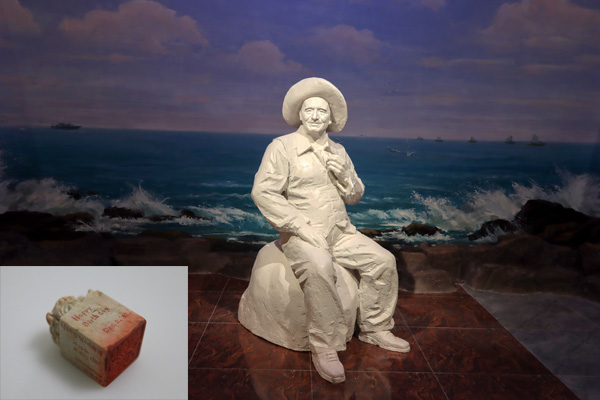
New Zealander Rewi Alley's statue and a seal he once used are on display at
Shandan Alley memorial museum in Zhangye, Gansu province. [Photo provided to China Daily]
Rewi Alley's approach to education equipped rural people with industrial skills, report Chen Meiling in Beijing and Ma Jingna in Lanzhou.
When New Zealander Rewi Alley passed through Shandan county, Zhangye of Gansu province, in the summer of 1943, he was impressed, as the natural landscape of the poor, remote and small county, featuring stunning hills and grassland, reminded him of his hometown of Springfield, Canterbury.
He was on his way to visit Yumen Oilfield in Jiuquan, Gansu province, together with British scientist Joseph Needham, and they stopped in Shandan along the way. Alley soon realized the county was an ideal new location for his occupational school in Shuangshipu town of Baoji, Shaanxi province, which had closed as a result of the War of Resistance Against Japanese Aggression (1931-45).
Shandan was far away from the battlefield and was rich in mineral resources, which was suitable for the school's professional research and teaching, says Zhang Xingmin, deputy director of Shandan Alley memorial museum.
The educator wanted to explore a new method that combined academic study in class and practical application at factories, a system to meet the needs of China at the time.
He established Shandan Bailie School, named after Joseph Bailie (1860-1935), an American educator and a pioneer in occupational education.
Despite strong winds and heavy snow, with school equipment and other goods on carriages, the first batch of about 60 students and 27 workers arrived in Shandan in December 1944. In March 1945, the second batch of students arrived.
Over the decades, the school has trained numerous technicians in sectors such as mechanics, petroleum and agriculture, many of whom have made a contribution to the country's development.
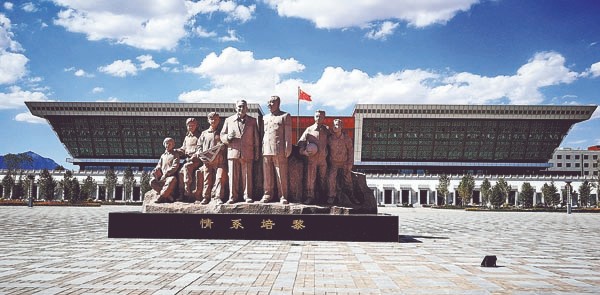
Shandan Bailie School in Zhangye, Gansu province. [Photo provided to China Daily]
In Shandan, the school has empowered poor children with valuable life skills and helped develop the county's industries and economy. Alley, who spent 10 years in the county during his six decades in China, is still remembered there and his influence continues to be appreciated.
Zhang says the school was highly integrated with real social demands. "It had no school uniform, so it founded a wool spinning workshop to make clothes. With a lack of food, it built a farm to plant wheat and vegetables. Then, it built factories producing leather, soap, glass, bricks and lime," he says.
He notes that the products were also liked by and sold to locals. Some old people still keep those products at home, saying: "They are not good-looking, but useful."
The school even built a boiler to generate power with steam. "At night, the school had electricity, so lots of residents would go to see it. For many, it was the first time in their lives that they had seen an electric lamp, and some refused to leave until dawn," Zhang adds.
Wang Zigang, former vice-principal of Shandan Bailie School, says: "The school's greatest value was that it brought modern industrial civilization to remote, underdeveloped northwestern areas, and cultivated talent for the construction of New China."
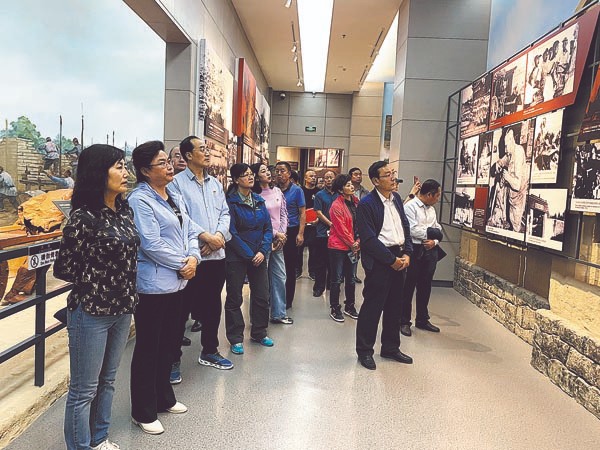
Visitors at the Shandan Alley memorial museum. [Photo provided to China Daily]
At the time, the school received about 600 students, drawn from poor families in Gansu and other 17 provinces. The farm, pasture and factories served as practice base for students.
Alley also built the county's first Western medicine hospital, received the first female student, introduced the first automobile, and built the earliest mechanized farm and semi-automatic coal pit, says Peng Dongjun, principal of Shandan Bailie School.
A total of 24 foreign teachers, from countries including the United Kingdom, the United States, Germany and New Zealand, imparted their knowledge to students. The school was also recognized overseas. Many foreign donors and sponsors to the school came to visit, including the then British ambassador to China. The education model was discussed at meetings of the United Nations Educational, Scientific and Cultural Organization, according to Zhao Qianxi, office director of the memorial museum.
In 1953, the school was moved to Lanzhou, Gansu's capital, and its management was transferred to the Chinese government, with Alley as honorary principal. The school is known as Lanzhou City University today.
In 1984, Alley proposed to the Chinese People's Association for Friendship with Foreign Countries building a new occupational school in Shandan, to improve its agriculture, animal husbandry and forestry industries. In 1987, the new Shandan Bailie School was opened, and is a national key technical secondary school.
According to Peng, the new school offers 12 majors, such as electromechanical technology application and modern agriculture, 51 laboratories and practical training workshops, 110 staff members and 2,090 students.
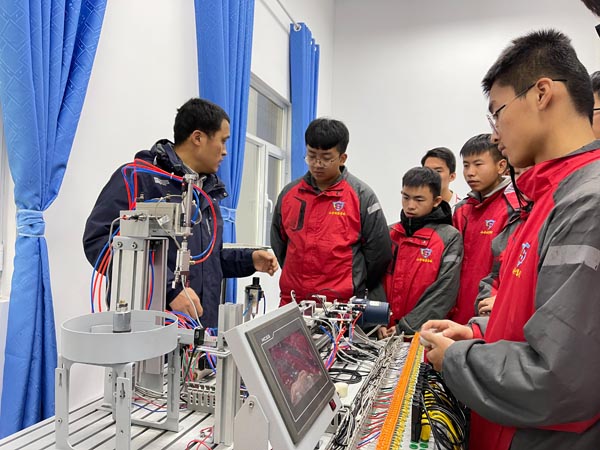
Students follow their teacher during a practical operation class at Shandan Bailie School. [PHOTO BY MA JINGNA/CHINA DAILY]
He says the school motto-"combining hands and brain, adopting creative analysis"-is inherited from Alley's idea of education, which advocates students' comprehension of multiple production skills through practical technical education, as well as being able to understand a situation and solve new problems with creativity.
He adds that the story of Alley, and his spirit of pursuing ones' dreams, selfless contribution and internationalism, is promoted among students.
In August 2012, Shandan opened the Alley memorial museum with photos and relics recounting his story. Entry is free and the museum receives about 100,000 visitors annually. In 1980, he donated about 4,000 historical items and a massive number of books from his collection to Shandan, to help build a cultural relics exhibition hall and a library in the county. He visited Shandan six times since he settled down in Beijing in 1953. He passed away in 1987 in Beijing. Half of his ashes were scattered at the school's former farm, and the other half was buried at the same cemetery in Shandan as the school's first British principal, George Hogg, who died in 1945.
As well as his experience in Shandan, since coming to China in 1927, Alley also worked and lived in multiple parts of China embroiled in war and the subsequent revolution, such as Shanghai, Hubei and Shaanxi provinces. He was a leader and founder of the Gung Ho movement, which organized jobless workers and refugees for production to support the War of Resistance Against Japanese Aggression. He also introduced New China at many international occasions.
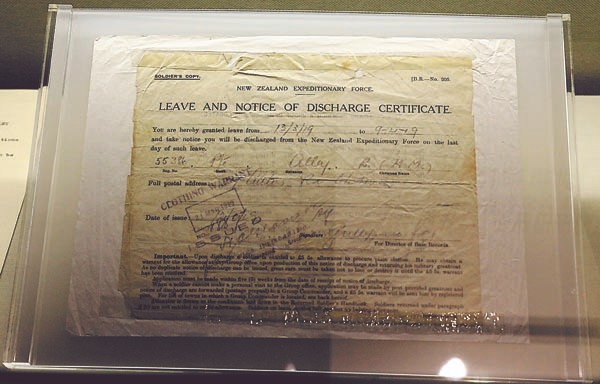
Rewi Alley's military discharge certificate from World War I. [Photo provided to China Daily]
To award his contribution to New China's construction, the Beijing and Gansu governments bestowed upon Alley the title of "honorary citizen" in 1982 and 1985, respectively. The Chinese People's Association for Friendship with Foreign Countries saw him named among the "top 10 international friends" in 2009.
Zhao from the museum says Alley's legacy is huge. "He broadened the horizon of locals and inspired many to start their own businesses. The factories laid the foundation for industrial development in the county. While they dug tunnels for the farm, they made archaeological discoveries."
He promoted exchanges between China and New Zealand. Gansu and Christchurch in New Zealand became sister regions in 1984.According to the local government, cooperation is seen in areas of culture, tourism, husbandry, agriculture and trade.
Xue Tao, a resident in Zhangye, says during Alley's 60 years in China, he not only helped bridge China with the world, but also pioneered modern Chinese occupational education, as he creatively combined the rural economy in remote and poor areas with his educational system in Shandan.
Zhang from the museum says: "Alley is a great fighter for internationalism, a social activist and is one of many international friends who have contributed to the Chinese revolution and the country's construction."